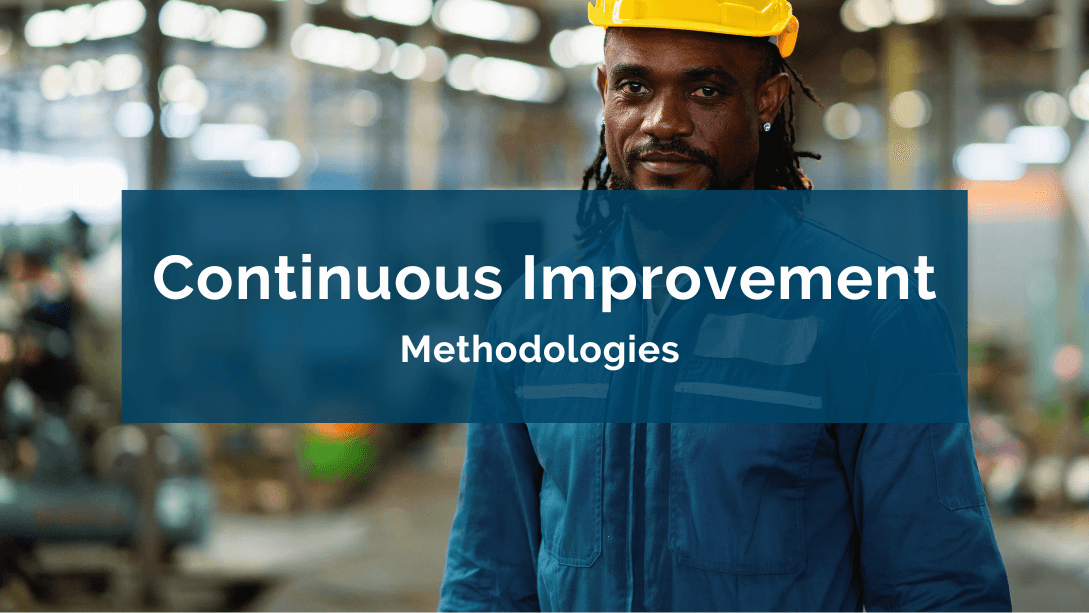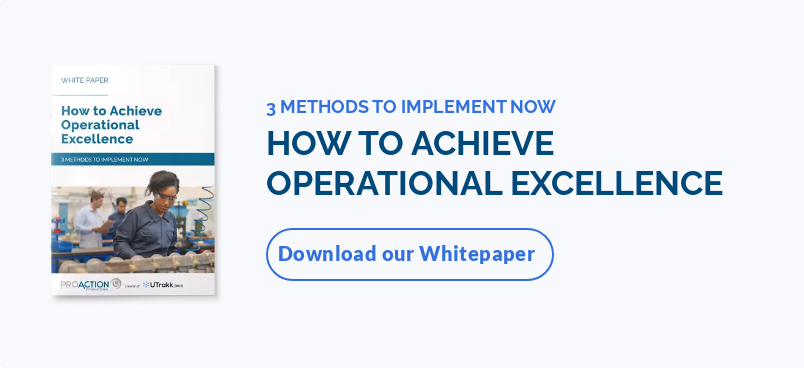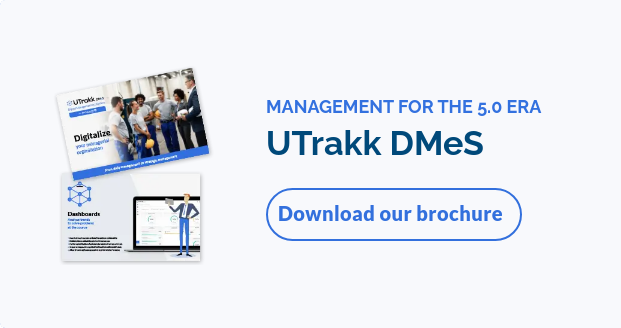What role do methodologies play in the continuous improvement process?
Structuring improvement efforts
Improvement methodologies define specific steps to be followed, from the initial analysis of procedures to implementing solutions.
This structure guides employees through an iterative process of planning, execution, monitoring, and adjustment, ensuring a consistent and systematic approach to continuous improvement. It provides a logical roadmap, keeping teams focused on predefined objectives.
Standardizing processes
Methodologies help to standardize business processes within an organization. By establishing common standards and practices, they reduce the variability of operations, creating a solid basis for assessing and improving performance.
This standardization also facilitates a common understanding of objectives and methods, bringing consistency to improvement efforts at all organizational levels.
Promoting a systematic approach to problem-solving and process optimization
By providing structured frameworks, continuous improvement methodologies offer precise tools and steps for identifying inefficiencies, eliminating waste, and improving operational quality.
They encourage in-depth analysis of current processes, the collection of accurate data, and collaboration between teams, creating a culture where each individual actively contributes to innovation and long-term efficiency.
Continuous improvement methodologies and tools
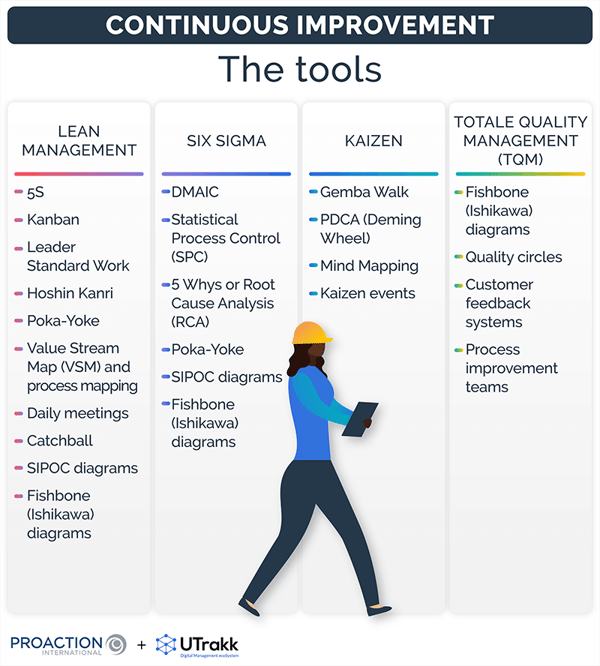
1. Lean Management
Inspired by the Toyota Production System, Lean methodology eliminates waste in manufacturing processes for greater efficiency.
It emphasizes principles such as the constant search for improvement, maximizing added value for the customer, reducing inventories, and flexible operations to meet variations in demand.
Lean Management tools and techniques:
- 5S: A 5-step method (Sort, Set in order, Shine, Standardize, Sustain) of organizing the workspace to improve efficiency and safety.
- Kanban: A visual system for managing tasks and stocks to maintain a continuous flow of production and avoid overloads.
- Value Stream Map (VSM) and process mapping: Visual techniques representing all stages of a process, from raw material to finished product, in detail and sequence to identify sources of waste and optimize efficiency.
- Daily meetings: Brief gatherings where team members discuss the progress of tasks, identify potential problems, and coordinate immediate actions to keep operations flowing smoothly.
- Leader Standard Work: Detailed documentation of best practices and procedures, providing a clear repository for operations.
- Catchball: An iterative process of discussion and idea sharing between team members, promoting a dynamic, collaborative exchange to develop solutions and make collective decisions.
- Hoshin Kanri: A strategic management method for planning, communicating, and aligning organizational objectives, promoting consistent and effective implementation of the continuous improvement model.
- SIPOC diagrams (Supplier, Input, Process, Output, Customer): Diagram providing an overview of the key stages of an existing process by describing the relationships between a system's suppliers, inputs, process, outputs, and customers.
- Poka-Yoke: Error prevention and verification mechanisms to eliminate defects at their source.
- Fishbone diagrams (Ishikawa diagrams): Visual tools to help analyze the root causes of problems by identifying the different categories of factors that can contribute to a fault or malfunction in a process.
2. Six Sigma
Six Sigma is a scientific method that reduces defects and process variability to improve quality and performance. This process improvement methodology uses statistical analysis and a structured problem-solving approach.
Six Sigma tools and techniques:
- DMAIC (Define, Measure, Analyze, Improve, Control): A structured method for solving problems and improving processes.
- Statistical Process Control (SPC): Statistical tools to monitor, measure, and control process variability, ensuring consistent production and compliance with quality standards.
- The 5 Whys or Root Cause Analysis (RCA): A method of root cause analysis in which the question "Why?" is asked repeatedly to identify the root causes of a problem and facilitate permanent rather than superficial resolution.
- SIPOC diagrams
- Poka-Yoke
- Fishbone diagrams (Ishikawa diagrams)
3. Kaizen
Kaizen is a Japanese term meaning "change for the better". It promotes continuous improvement through small, frequent, and progressive changes.
It relies on the involvement of all organization members in the process.
Kaizen tools and techniques:
- Gemba Walk: Direct observation in the workplace to understand processes and identify opportunities for improvement.
- PDCA (Plan, Do, Check, Act or Deming Wheel): Continuous improvement cycle consisting of planning, implementing, evaluating, and adjusting an action plan.
- Mind Mapping: A visual representation of existing processes, identifying opportunities for improvement, and organizing ideas generated during brainstorming sessions.
- Kaizen events: Collaborative sessions, usually over a short period, aimed at identifying, analyzing, and rapidly resolving operational problems to improve processes.
4. Total Quality Management (TQM)
Total quality management is an organizational approach that aims to integrate quality at all company levels, engaging all personnel in continuously improving processes, products and services to achieve overall operational excellence.
TQM tools and techniques:
- Fishbone diagrams (Ishikawa diagrams)
- Quality circles: Groups of employees meeting regularly to identify, analyze, and resolve specific operational problems.
- Customer feedback systems: Mechanisms for collecting, analyzing, and using customer feedback to guide improvements and ensure ongoing satisfaction.
- Process improvement teams: Dedicated groups working together to identify, analyze, and implement improvements in operational processes, thus contributing to overall quality and performance optimization.
Key benefits of continuous improvement methods
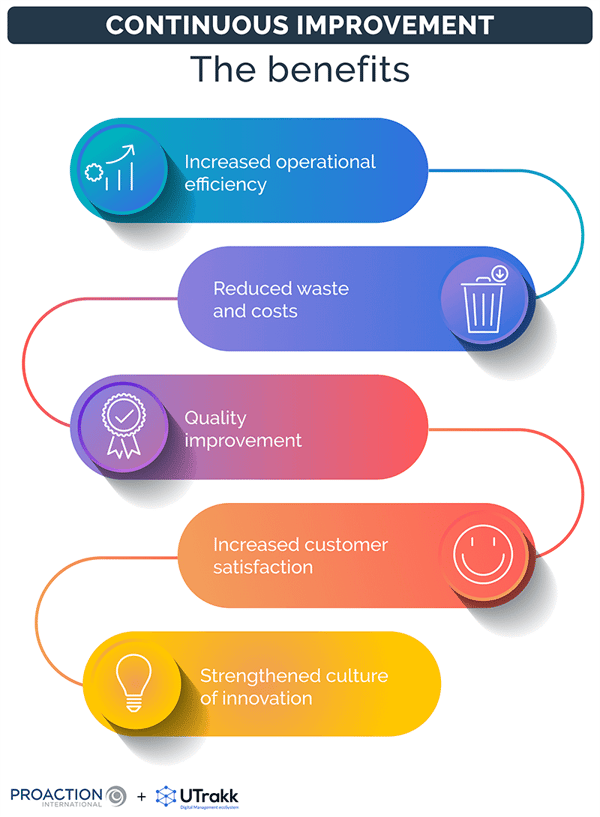
Increased operational efficiency
The use of continuous process improvement methodologies makes identifying and eliminating inefficiencies possible.
The result is more judicious use of resources, shorter production times, optimized workflows, and better use of working time, all of which multiply operational efficiency.
Reduced waste and costs
Lean methods
focus on eliminating waste, including excess inventory, waiting times, and unnecessary movements.
By reducing these sources of waste, organizations minimize the associated costs, whether in terms of raw materials, labor, or storage space. This cost reduction contributes directly to improving the company's overall profitability.
Quality improvement
Focusing on Six Sigma methodology, this approach enhances product and service quality by identifying and eliminating the root causes of defects. The result is less scrap, fewer customer returns, and lower error-related costs.
This increase in quality also enhances the organization's image and reputation.
Increased customer satisfaction
Continuous improvement often translates into improved customer satisfaction. Optimized processes, higher-quality products, shorter delivery times, and better responsiveness all contribute to meeting customer demands. The result? Loyal customers.
Strengthened culture of innovation
The organization creates an environment where innovation is valued by encouraging employees to identify and solve problems and proposing solutions for continuous improvement. More agile, it can also adapt more rapidly to market changes.
How to implement continuous improvement methodologies
Implementing constant improvement methodologies requires a structured and committed approach. Here are a few key steps to guide you through the process:
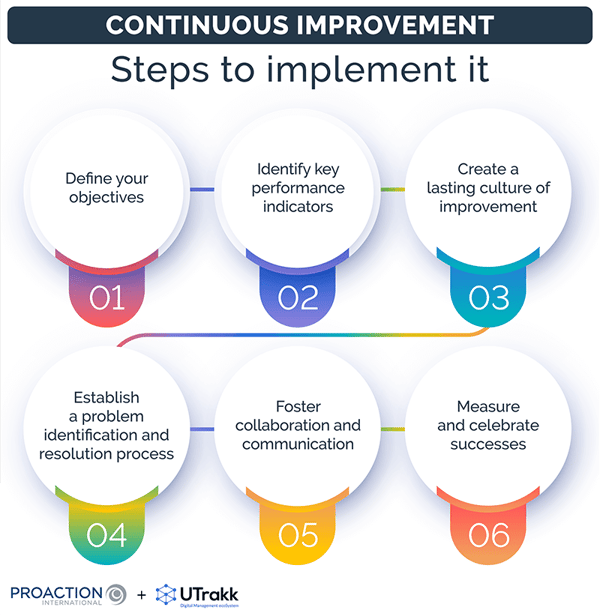
1. Define your objectives
First, it is essential to define clearly the objectives you wish to achieve. These must be aligned with the company's overall strategy. They must also be specific, measurable, achievable, relevant, and time-bound (SMART goals).
Defining precise objectives provides direction for continuous improvement efforts and makes it easier to assess progress.
2. Identify key performance indicators
Determine the key performance indicators used to evaluate the success of your continuous improvement initiatives. These KPIs must be closely linked to the objectives defined above. For example, if the aim is to reduce production lead times, the KPI could be manufacturing cycle time.
Monitoring these KPIs makes it possible to measure progress and adjust improvement efforts accordingly.
3. Create a lasting culture of improvement
The successful implementation of continuous improvement methods relies on creating an organizational culture that values novelty and constant progress.
Encourage the active participation of all organization members by setting up feedback mechanisms. Ensure that employees understand the principles and methods of continuous improvement. Make them aware of the benefits of continuous improvement to motivate their active participation.
Offer training tailored to the needs of each team, focusing on the skills required to implement the chosen methodologies.
Involve employees at all levels in the improvement process to foster ownership and engagement.
4. Establish a problem identification and resolution process
Develop a process for identifying and resolving problems within the organization. Encourage the proactive collection of ideas and feedback and set up dedicated problem-solving teams.
A structured process, such as DMAIC (for Six Sigma) or PDCA (for Kaizen), can ensure a systematic approach.
5. Foster collaboration and communication
Collaboration between teams and departments is another critical factor in continuous improvement. Set up effective communication channels to share best practices, lessons learned, and progress made.
Hold regular team meetings to discuss ongoing initiatives and align everyone's efforts with organizational goals.
6. Measure and celebrate successes
Set up a progress monitoring system using the KPIs defined above. Celebrate successes, even small ones, to boost team motivation and show that you are aware of the efforts made.
Continuous learning from successes and failures is essential to constantly adjust and improve existing methodologies.
One last important piece of advice: choose the methodologies best suited to your context. For example, Lean production may be preferred to eliminate waste, while Six Sigma will be more relevant for reducing variability. Next, make sure that the continuous improvement tools selected are well understood and accepted by the members of the organization.
The role of management and employees in continuous improvement
A culture of continuous improvement is an essential driver of organizational growth. It fosters adaptability, strengthens competitiveness, and places the company in a privileged position to respond to market challenges. But who sows the seeds of this culture?
Leaders play the key role. They must define an understandable vision of the importance of continuous innovation and process optimization. This implies transparent communication on the strategic objectives linked to continuous improvement. Their leadership, personal commitment, allocation of adequate resources and creation of a stimulating environment are fundamental to instilling a continuous improvement mentality within the company.
But they are not the only players involved. Employees also play a central role. Indeed, engaged workers are more likely to contribute actively by identifying opportunities for improvement, proposing new ideas and participating in the resolution of operational problems. Their involvement creates a collective impetus towards efficiency, quality and innovation, reinforcing the continuous improvement culture by making each and every one of them a driver of positive change.
Fostering a culture of continuous improvement to stimulate growth
By implementing a culture of continuous improvement, organizations arm themselves with powerful methods and effective tools to optimize their processes, increase operational efficiency, and stimulate innovation. The benefits resulting from these approaches are manifold, from increased productivity and cost reduction to improved quality and customer satisfaction.
In today's fast-changing competitive landscape, continuous improvement is no longer simply an advantage, but a necessity. It offers manufacturing companies the flexibility they need to adapt to market changes and strengthen their competitiveness. It positions them as proactive entities in an ever-changing world.




